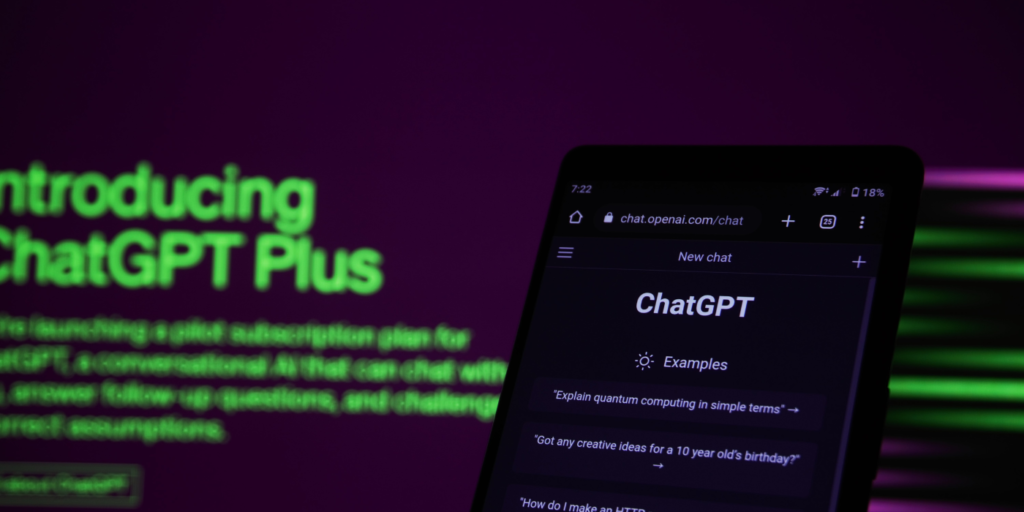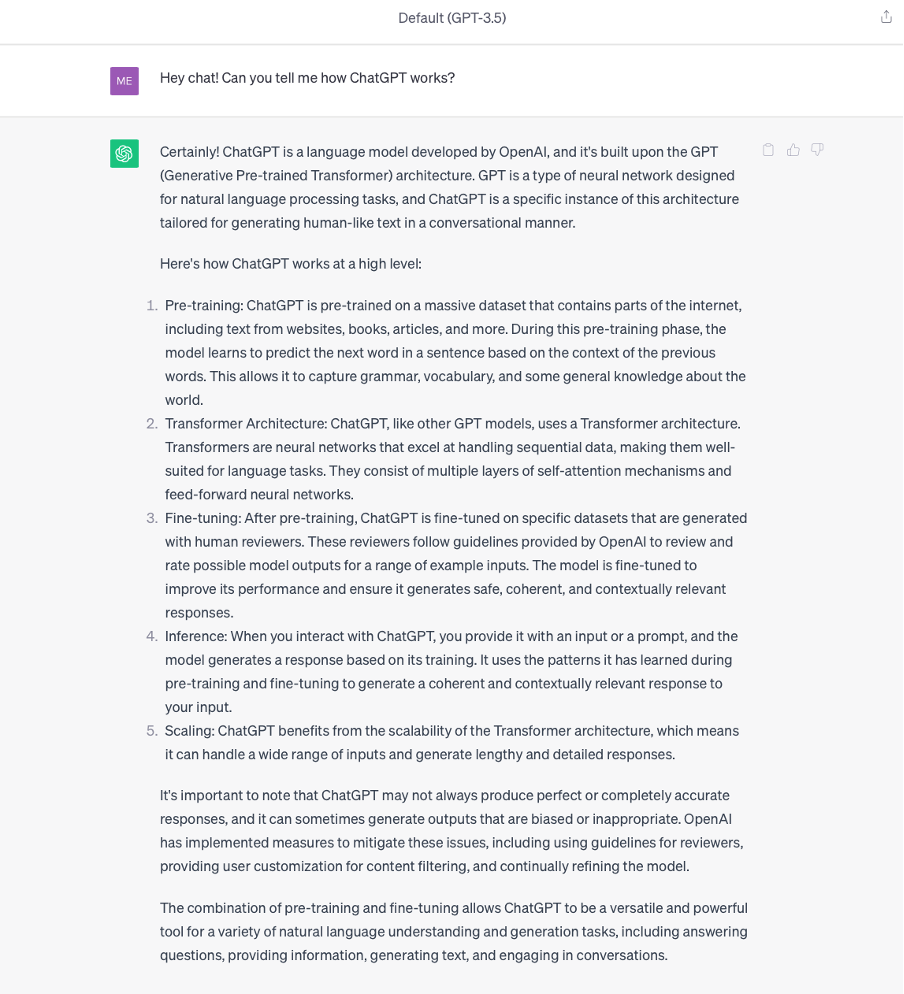It’s nearly been a year since ChatGPT entered the conversation, triggering AI to gain a permanent spot at the top of every marketer’s trends-to-watch list. After the release of the Open AI chatbot, other tech giants were quick to join the race with AI products that have the potential to change the game. Google released Bardearlier this year in March, and last week Meta announced Meta AI, a human-like chatbot that takes the personas of celebrities such as Kendall Jenner, Snoop Dog and Paris Hilton. You have to see it to believe it.

At first, the sudden advance in AI technology was a little daunting for us content marketers. But we are 12 months on, we’ve given AI content creation a real go, and we’ve concluded that it won’t be giving us a run for our money yet.
But AI worming its way into our workflow and business operations is pretty much inevitable, so to stay on top of our A-game, we’ve got to get ahead. This blog is our complete guide to AI content generation – how it works, its limitations and when we should consider using it (and spoiler alert, we don’t mean to write great words).

What is AI Content Generation?
In a nutshell, AI content generation is the process of using AI-powered tools to create content. From words to visuals, some tools can generate “creative” content in less than the time it took for us to write this sentence.
While AI isn’t new, it’s gained a permanent place in the spotlight due to the increase of AI chatbots entering the market. Using a language-based AI model, these chatbots respond to text you input by generating answers based on the learned data.
With these language-based AI tools, you can create anything word-based. From songs, poems and recipes to long-form blogs, social media captions and newsletter headlines. It’s impressive stuff that can cut the time spent on the creative process in half, but whether or not the content it generates hits the mark is another question.
Aside from artificially generated words, there has also been a recent rise in apps and programs that can create or edit artwork. From background remover tools to image generators, AI can create interesting art – or at least assist in the process. But whether or not it’s original art or not is a discussion for a little later.
Many of these tools have been around for a while, and AI is already powering a lot of the software that content marketers use on a daily basis. When Hootsuite suggest a prime time to post your content? That’s AI. When Mailchimp suggests ways to improve your headline? That’s AI, too. And when Grammarly offers ways to remove the passive voice from your text, you guessed it, it’s also using AI.
How Does AI Content Generation Work?
AI is essentially a big old algorithm. It’s fed data, it learns from that data, and it generates responses based on those things that it learned. It requires frequent updates to stay current, and careful consideration of the data it is given is essential – the wrong kind and AI can quickly become biased, highly inaccurate and potentially a little dangerous.
Large language models, like ChatGPT, work in a slightly more complex way than tools integrated into other software. They digest vast quantities of data and are trained to infer relationships between words within the texts. Once it understands how words are used and sentences are formed, it can use this pre-trained knowledge to generate answers to prompts, questions and ideas. And tools like ChatGPT are also able to tailor their answers based on previous prompts and questions asked in the same session.

Examples of AI Content Generators
ChatGPT isn’t the only note-worthy AI tool. This year has seen record-breaking growth in the AI market. This summer, over 7000 AI tools were available to the general public; the search term ‘AI tools’ has increased dramatically worldwide, and the market value continues to grow by billions. Here are some of the best AI tools worth making jotting down:
ChatGPT: we’ve already gone into a lot of detail about this AI content generation tool. But if you haven’t used it, we recommend giving it a go.
SummarAIze: an AI-powered tool that repurposes your audio and video content into engaging, shareable social posts, email content and summaries.
Jasper: specialising in creating long-form content like blog articles, scripts and outline, Jasper uses your tone of voice guidelines to try and create content that sounds like you.
GrammarlyGO: any good copywriter will have used Grammarly at least once in their career. This integrated tool helps give your old work new life. (NB, this post was edited using Grammarly.)
Writesonic: writing blogs, ads and emails; this tool runs on OpenAI’s GPT-4 model and offers a chatbot called Chatsonic to fill the gaps left by ChatGPT specifically.
Bard: a natural language processing tool that’s connected to Google, you can collaborate with Bard to brainstorm ideas, spark creativity and accelerate your content process.
Copy.ai: this AI tool can scan blogs and webpages to create tweets, social media carousels and other types of content.
Benefits of AI-generated content
We will preface this section by saying that while AI can bring several advantages to the content creation process, it is a tool and should be used as such. Here are the pros of using AI for content creation:
Fast publication of content
Some industries require ideas and published articles at speed, and AI can help you save a few hours spent scratching your head as you look for the right words. As an added bonus, ChatGPT or similar large language models can learn as they go. This means that with the right prompts, and if it is fed the right data, it will only get better at writing in your style or tone. AI can be a great time saver for repetitive content that you may require to tick a box or fill a space.
Cost-effective AI content creation
For one-person teams or solo ventures, missing out on creative brainstorming sessions can take a toll on content creation. Generating content ideas, creating drafts, and evolving starting points with an AI content generator can kick-start the process. You’ll save money you may have spent employing the expertise of a professional or seeking paid resources online. However, when it comes to the execution of this idea, we recommend investing in a service that can take the reins and actually deliver.

Beat writer’s block
We all get it; it creeps up when deadlines are near, and the pressure to deliver is on. Of course, I’m talking about writer’s block. The bane of every writer’s life, AI is a quick solution to getting out of a funk. Tell it what you are writing and what you want to achieve, and use the results as a bit of inspiration to get you back on the writing train. Ai is likely to produce a lot of questionable copy, but hopefully, there will be one sentence – or even one word – that fits the puzzle well enough to help you complete it.
Quick translation
Did you know AI can translate your work for you? Yeah, I guess you’re not that surprised because Google Translate has been doing this for Donkey’s years. But ChatGPT and Google Translate differ because the former makes sense, while the latter is unpredictable. And I’m not kidding – to our surprise, ChatGPT’s translation skills are pretty accurate. AI is worth using if you’re entering a market with your products or need to send a quick email abroad. It’s fast, free and great to use when the impact isn’t that important. But if you’re publishing more in-depth content in a language that isn’t your own – and if capturing people’s attention is essential, a professional translator who knows a thing or two about localisation is always your best bet.
Limitations of using AI to generate content
But for all of its good parts, AI obviously has its flaws – and it’s up to you to decide which side wins. Here are the limitations of using AI for content generation:
Originality concerns
AI creates content by reading, memorising and understanding other content. So, in a nutshell, it takes *a lot* of inspiration from different (and similar) works online to generate content as per your requests or prompts. So, what does this mean for your content?
- The content it generates could sound and look like similar content already published online.
- If multiple people were to ask AI to generate a piece of content based on the same prompt, it’s likely to generate very similar content – or even identical content in a few situations.
- Without originality – which includes your brand’s personality and your own opinions or expertise – the Internet would quickly become a cookie-cutter results page of boring content that lacks actual ideas and insight. And who wants that? We predict that ordinary web users (as opposed to battle-hardened marketers) will begin to notice content that has been generated by AI very soon – wait for it to become “a thing”.
Inconsistent quality
We get that time, or lack thereof, can be stress-inducing. And when we are stressed, the temptation to tick off our to-do lists at the speed of light is beyond tempting. Now, put yourself in your customer’s shoes. Six months ago, they signed up for your newsletter because they liked your ideas and were intrigued by what you had to say. You sent out weekly emails with really in-depth, niche content. Fast-forward to now, and you start using AI to cut the content creation process in half. Great. But in doing so, your content quality suddenly drops in quality, and those subscribers feel let down, a bit bored and very tempted to hit that unsubscribe button. Not so great. Flitting between AI and human content isn’t a great idea. When consistency is paramount, how you say things needs to stay the same.
It lacks emotion
We’ve said it before, and we’ll say it again (and again and again): AI-generated content, at present, is NOT the same as human-written content. AI-created copy lacks emotion; it doesn’t have experience; and – to no surprise – it doesn’t know what it’s like to actually exist in the world, so when it comes to addressing pain points, it can only make assumptions. And we’re not just saying this because we are a copywriting agency that is Team Human all the way. Yes, we would die on that fence, but even ChatGPT agrees that human-written content is irreplaceable right now.

Ethics, facts and accuracy
And lastly – but perhaps the most important of all – using AI for content generation might not be as spot-on as it appears to be. The thing is, AI can get things wrong. On top of this, when humans are responsible for creating the AI machines, there is potential for manipulation. AI works by learning data, and if the data is not inclusive of the people it is designed to help, you can expect its generated content to be biased and even perpetuate stereotypes. On top of this, feeding AI inaccurate information will only mean it does the same for you – and if you’ve asked AI to write something on a topic you know little about, you run the risk of spreading misinformation. When brand reputation is everything, this is the last thing you want to be doing.
Use cases of AI content creation
We can hear you asking it, Can I use AI?’ and the answer is neither yes nor no. It really comes down to personal judgment. Ask yourself: why are you creating this content? What do you want this content to achieve? If you’re creating mundane content that fills a box or text needed for a specific function, you might get away with it. For example:
- Short instructional paragraphs
- Headlines or headings
- Your website’s privacy policy
- Survey questions
- Call to actions
However, if you’re looking to create valuable content that people will either enjoy reading or learn something from the copy, we recommend getting a copywriter on board who knows how to write well. For example, we don’t recommend using AI to write:
- Long-form blog content
- News articles
- Case studies
- Website copy
- Social media content.

We’d also argue that you shouldn’t use AI for product descriptions, tempting as it might be. Lots of brands want to automate product description writing as much as possible – because you might have thousands to write, and that’s expensive and time-consuming. But automation means they become dull, repetitive and (often) duplicated. If that’s your approach – and we understand it from a budget point of view – we’d urge you to think again. Well-considered, original and innovative product descriptions are an opportunity to amplify your tone of voice and act as your virtual sales assistant, increasing conversions and reducing returns. Our tip: pick the top 10 – 20% of your most profitable product pages and experiment with longer and more creative descriptions.
Back to the AI overview… In short, if the content’s execution is unlikely to change its interaction with its reader, AI will do. But if the words determine the result, a copywriter is required.
Best practices for using AI to generate content
With that in mind, if you are using AI to create content, here are a few things you should keep in mind:
- Write the right prompt: define your goals and tell the AI tool what you want in detail. Provide previous examples of your work and ask it to replicate the tone and style.
- Select the right tool: each tool does different things, so you need to pick one with the best features for your goal.
- Fact check your work: plagiarism is rife in AI-generated content, so we recommend running any content you create using AI through a plagiarism checker before publishing. Likewise, any facts, figures or sources referenced by AI will need checking, too – it’s excellent at getting things wrong!
- Get good at editing: no matter the use, the content generated by AI will need editing. From generating words that the normal person wouldn’t use to following a slightly unnatural structure, it’s safe to give it a once over before setting it free into the world.
The future of AI content generation
We don’t know what the future of AI content generation will look like. But we do know that it’s advancing quickly, so it’s best to get on its side. Use it to make your life easier and help you create great content; by using AI, copywriters can tap into a super-human brain of thoughts and ideas. Let AI fill in the gaps. Your work might thank you for it. But tread with caution because it’s not a perfect machine – for the meantime, anyway.
If you’re unsure of how to make a start with creating great content, ask for help from professionals – like us. Our team has been crafting compelling copy since before the iPhone (yep, we’ve been around for a while!), and we know a thing or two about how to make it resonate with audiences and drive results.
We won’t subject you to robotic copy or send you to sleep with repetitive words with no value. Don’t hesitate to get in touch to discuss your copywriting needs. We’d love to help!
